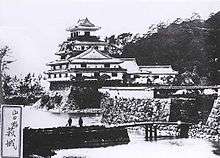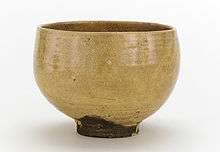Hagi, Yamaguchi
| Hagi 萩市 | ||
|---|---|---|
| City | ||
|
Hagi castle town | ||
| ||
 Location of Hagi in Yamaguchi Prefecture | ||
 Hagi Location in Japan | ||
| Coordinates: 34°24′N 131°24′E / 34.400°N 131.400°ECoordinates: 34°24′N 131°24′E / 34.400°N 131.400°E | ||
| Country | Japan | |
| Region | Chūgoku (San'yō) | |
| Prefecture | Yamaguchi Prefecture | |
| Government | ||
| • Mayor | Kōji Nomura | |
| Area | ||
| • Total | 698.86 km2 (269.83 sq mi) | |
| Population (May 31, 2016) | ||
| • Total | 50,179 | |
| • Density | 71.80/km2 (186.0/sq mi) | |
| Time zone | Japan Standard Time (UTC+9) | |
| Website |
www | |
Hagi (萩市 Hagi-shi) is a city located in Yamaguchi Prefecture, Japan, which was incorporated on July 1, 1932.
As of May 31, 2016, the city has an estimated population of 50,179 and a population density of 71.80 of persons per km². The total area is 698.86 km².
History

In the medieval period, Hagi was dominated by the Yoshimi clan, who built Hagi Castle, the ruins of which can be visited today. The Mōri clan became daimyo of Chōshū Domain at the beginning of the Edo period and built Hagi Castle at the foot of Mt. Shizuki in 1608. They transferred the capital of the domain from Hiroshima to Hagi at the same time. Since then, Hagi developed as the political center of Chōshū for over 250 years.
When the Meiji Restoration came about in the 1860s, as the result of efforts by samurai from Chōshū and a number of other domains, this small city gained great historical significance. Many Japanese statesmen and Prime Ministers were born and brought up in this city.
On March 6, 2005, Hagi absorbed the towns of Susa and Tamagawa, and the villages of Asahi, Fukue, Kawakami and Mutsumi (all from Abu District) to create the new, expanded city of Hagi.
Population
One of the factors underlying the continual decrease of population is said to be its poor public transport. Industry did not grow at all and the rapid economic growth of Japan only caused the town to decline. But it also kept the traditions alive and the traditional look of the town preserved.
| Historical population | ||||||||||||||||||||||||||||||||||
|---|---|---|---|---|---|---|---|---|---|---|---|---|---|---|---|---|---|---|---|---|---|---|---|---|---|---|---|---|---|---|---|---|---|---|
|
| |||||||||||||||||||||||||||||||||
| Source: [1] | ||||||||||||||||||||||||||||||||||
Climate
| Climate data for Hagi, Yamaguchi (1981-2010) | |||||||||||||
|---|---|---|---|---|---|---|---|---|---|---|---|---|---|
| Month | Jan | Feb | Mar | Apr | May | Jun | Jul | Aug | Sep | Oct | Nov | Dec | Year |
| Record high °C (°F) | 18.8 (65.8) |
23.6 (74.5) |
25.9 (78.6) |
30.7 (87.3) |
32.0 (89.6) |
34.3 (93.7) |
36.6 (97.9) |
37.9 (100.2) |
37.4 (99.3) |
32.0 (89.6) |
26.5 (79.7) |
21.6 (70.9) |
37.9 (100.2) |
| Average high °C (°F) | 9.2 (48.6) |
10.0 (50) |
13.0 (55.4) |
18.1 (64.6) |
22.2 (72) |
25.3 (77.5) |
29.3 (84.7) |
30.8 (87.4) |
26.8 (80.2) |
22.1 (71.8) |
17.1 (62.8) |
12.0 (53.6) |
19.7 (67.5) |
| Average low °C (°F) | 2.5 (36.5) |
2.6 (36.7) |
4.6 (40.3) |
9.1 (48.4) |
13.7 (56.7) |
18.3 (64.9) |
22.8 (73) |
23.7 (74.7) |
19.5 (67.1) |
13.4 (56.1) |
8.7 (47.7) |
4.5 (40.1) |
12.0 (53.6) |
| Record low °C (°F) | −5.8 (21.6) |
−6.8 (19.8) |
−3.9 (25) |
−0.3 (31.5) |
3.0 (37.4) |
8.6 (47.5) |
12.2 (54) |
15.2 (59.4) |
8.1 (46.6) |
3.9 (39) |
0.6 (33.1) |
−3.8 (25.2) |
−6.8 (19.8) |
| Average rainfall mm (inches) | 90.0 (3.543) |
79.0 (3.11) |
124.2 (4.89) |
118.8 (4.677) |
147.5 (5.807) |
227.2 (8.945) |
265.0 (10.433) |
139.2 (5.48) |
207.3 (8.161) |
92.7 (3.65) |
91.6 (3.606) |
75.7 (2.98) |
1,658.2 (65.282) |
| Average rainy days | 22.6 | 19.7 | 19.7 | 15.3 | 14.6 | 16.3 | 17.4 | 14.8 | 16.8 | 13.8 | 16.5 | 20.5 | 208 |
| Average relative humidity (%) | 67 | 67 | 71 | 71 | 74 | 80 | 81 | 78 | 79 | 75 | 72 | 68 | 73.6 |
| Mean monthly sunshine hours | 77.0 | 95.6 | 141.4 | 181.7 | 197.8 | 151.1 | 165.6 | 205.7 | 155.2 | 167.1 | 119.6 | 92.1 | 1,749.9 |
| Source #1: Japan Meteorological Agency[2] | |||||||||||||
| Source #2: Japan Meteorological Agency[3] | |||||||||||||
Economy
Iwami Airport in nearby Masuda, Shimane Prefecture serves Hagi.
Tourism is a strong factor of the town.
Hagi ware
The city was the capital of the Chōshū Domain during the Edo period (ca. 1603–1868). Hagi is renowned for Hagi ware, a form of Japanese pottery dating from 1604 when two Korean potters were brought to Hagi by Lord Mōri Terumoto.
Hagi was also the location for an International Sculpture Symposium in 1981. Twenty-six international sculptors working worked together to create a seaside park. They created many functional sculptures, including tables and benches.
People
- Yoshida Shōin (1830-1859), intellectual, teacher and revolutionary
- Inoue Masaru, known as the "Father of the Japanese Railways".
- Katsura Taro, former prime minister of Japan.
- Kido Takayoshi
- Omura Masujiro
- Takasugi Shinsaku
- Tanaka Giichi, former prime minister of Japan.
- Yamagata Aritomo, former prime minister of Japan.
Sister cities
Since 1968, Hagi has been a sister city to Ulsan (울산광역시, 蔚山廣域市 www.ulsan.go.kr), a fishing port and Korea Industrial capital of Hyundai motor's world's largist motor assembly compelex with proving ground and in-house port:capacity 1.5million unit per year, Hyundai heavy industries' world's top shipyards and largist petrochemical complex like SK & S-OIL refineries in the southeast of South Korea.
References
- ↑ National Census by Statistics Bureau Japan
- ↑ "平年値(年・月ごとの値)". Japan Meteorological Agency. Retrieved 2011-10-07.
- ↑ "観測史上1~10位の値(年間を通じての値)". Japan Meteorological Agency. Retrieved 2011-10-07.
Further reading
- Gregg, N. Taylor (June 1984). "Hagi: Where Japan's Revolution Began". National Geographic. Vol. 165 no. 6. pp. 751–773. ISSN 0027-9358. OCLC 643483454.
External links
| Wikimedia Commons has media related to Hagi, Yamaguchi. |
- Hagi City official website (Japanese)
-
 Hagi travel guide from Wikivoyage
Hagi travel guide from Wikivoyage


